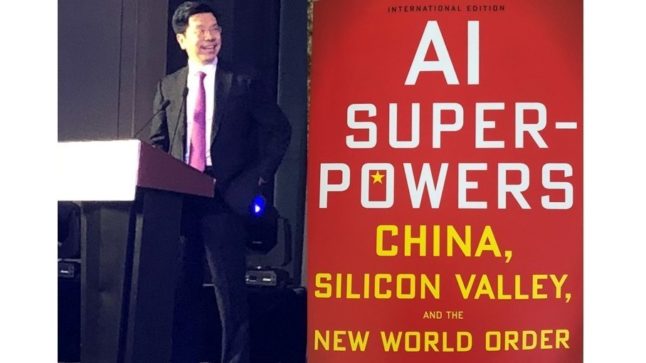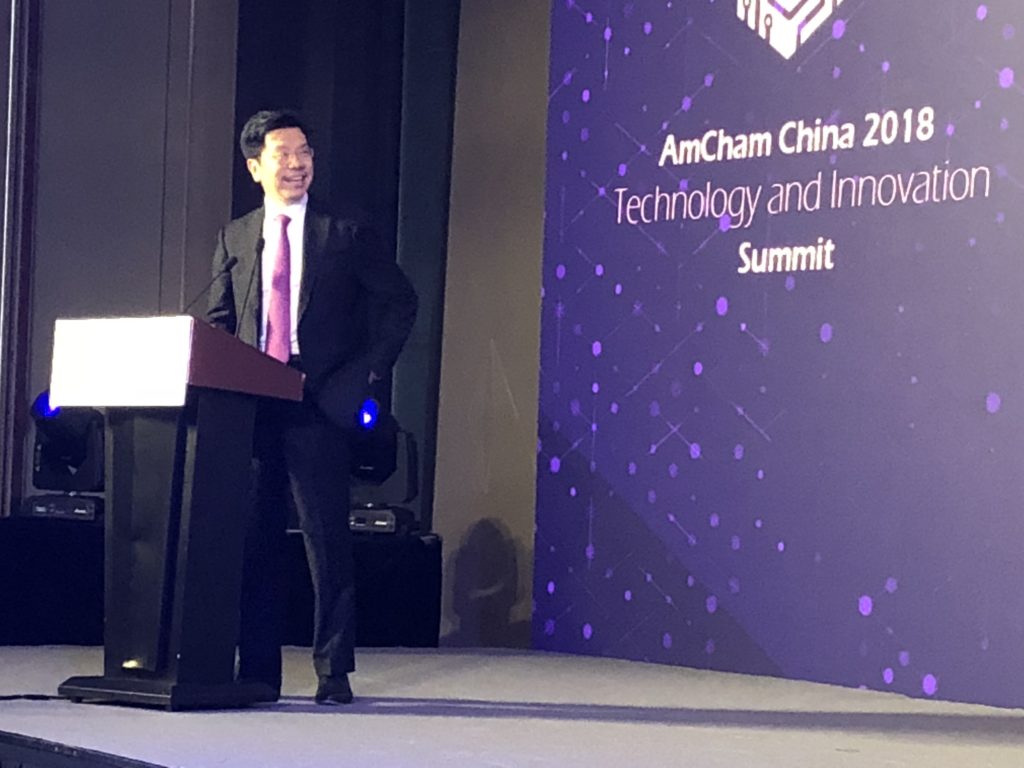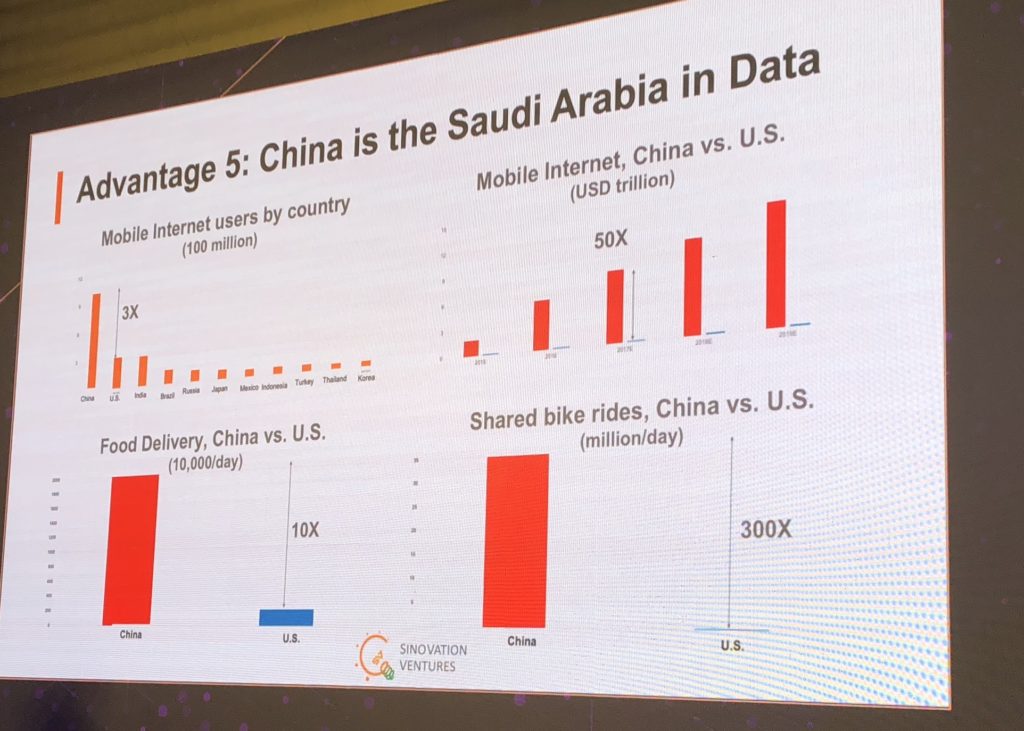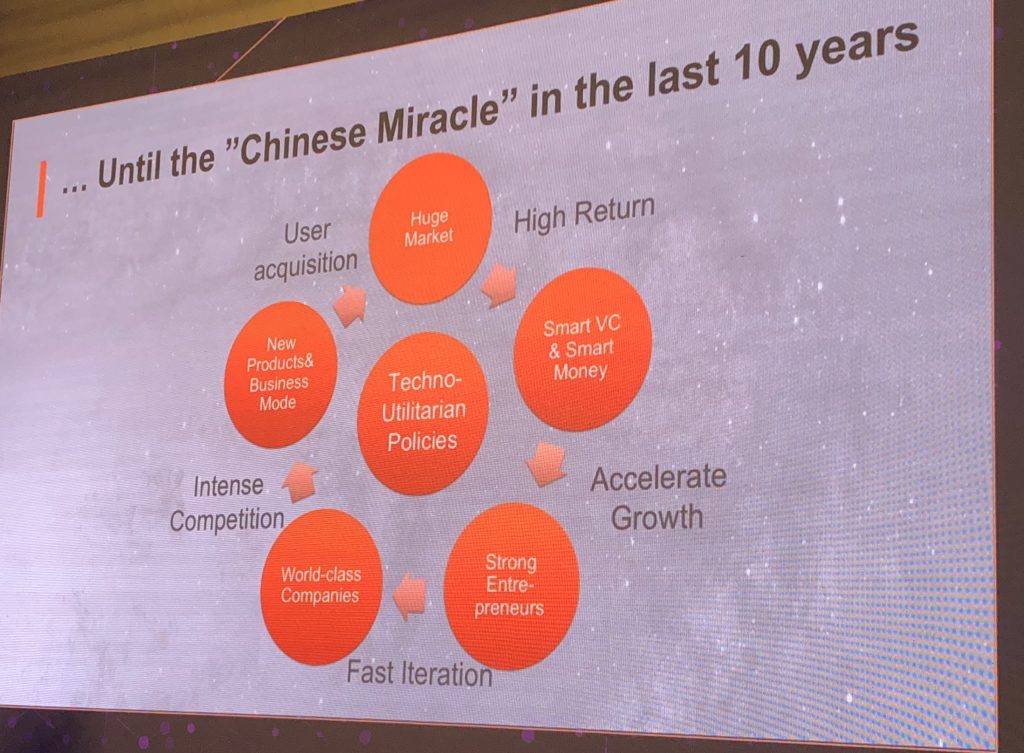Key concepts for this article:
- Artificial Intelligence
- China’s State Capitalism model
***
The release of ChatGPT and DALL-E has pushed AI back to the forefront of digital. Forget web3 and blockchain. It’s all about AI now.
And I will confess, I am a believer. Artificial intelligence is the biggest thing happening in digital. I’m even learning write Python, the primary programming language for AI.
I recently went back and re-read China AI guru Kai-Fu Lee’s book AI Superpowers. It broadly compares artificial intelligence in China and the USA. I was also fortunate to hear him present part of his book at an AmCham event in Beijing back in 2018. I went back and pulled out my photos from that.
The book itself doesn’t go into AI or business questions particularly deeply. It’s more personal and high-level. But peppered throughout are some fascinating details about how AI is evolving in China vs. the US. And the presentation was very good. So here are my 10 take-aways.
Lesson #1: China Will Be a Leader in AI’s Age of Implementation
One of Dr. Lee’s main points was the below chart (from his AmCham talk). His point was that we are moving from an age of discovery to one of implementation in AI. And China, already an AI leader, is better positioned to win in implementation.
AI is no longer all about elite cutting-edge AI researchers making big breakthroughs (which the USA is better at). It is also about taking existing discoveries and applying them to use cases. It is about implementing them in companies and industries, which takes a long time. He cited several key factors that matter in the age of AI implementation – such as the need to have lots of AI engineers, a robust entrepreneurial culture and favorable government policies. And China is very strong in those particular areas.
Lesson #2: China Has an Advantage in Data – and That Can Really Matter in AI.
Dr. Lee argued that successful AI algorithms need three things: computing power, big data and an army of solid but not elite AI engineers. However, once you get to a sufficient volume of engineers and computing power (which both the US and Chain have), it is the data that makes the difference. Having more data is how you win. And China has a wealth of data, especially on the consumer side.
It is really the consumer side of digital China (my area) that matters. The enterprise-side of digital China is not as developed and evolves slowly (try getting SOEs to digitize). But on the consumer side (Tencent, Alibaba, Didi, etc.) things happen very fast in China and there is tons of data. Manufacturing in China is also pretty fast.
China has already surpassed the US in quantity of data on the consumer side. But he argues that the quality of data is also superior in many ways. Chinese consumers are living in the real world things on their phones. This includes food delivery, on-demand masseuses, bike riding, bus tickets, and just about everything else. Mobile payments are generating valuable data about what consumers buy and eat, where they are and how they commute. This is a digital-first society. And there is a sea of data about actions in the real world – which is a lot more valuable than online data such as likes and clicks.
Lesson #3: China’s Scrappy Entrepreneurs Are their Secret Weapon in AI.
I was happy to read Dr. Lee’s comments about China’s entrepreneurs. My mantra for many years has been that digital China’s defining factor is not just its big markets. It is the ferocious competition and the battle-hardened companies it produces. It’s hard to explain if you haven’t been on the ground and seen the companies operate. It is a ferociously entrepreneurial society.
Dr. Lee repeatedly talked about China’s scrappy entrepreneurs and their “sharp instincts for building robust businesses.” He said Silicon Valley looks “downright sluggish compared to its competitor across the Pacific”.
In his book, he had a good summary of digital China – saying “survival in the internet coliseum required relentlessly iterating products, controlling costs, executing flawlessly, generating positive PR, raising money at exaggerated valuations, and seeking ways to build a robust business “moat” to keep the copycats out”.
That is a pretty great summary.
Keep in mind, China’s digital giants (Alibaba, Tencent, Didi) are the champions of a ferocious market. They have beaten off tens if not hundreds of competitors. So when a company like ByteDance takes on Facebook, I usually bet on the Chinese company. And they aren’t just good at competing and coding. They are also good at navigating messy markets and responding to dirty tricks.
He had a good slide about the “China Miracle”.
Lesson #4: AI-Driven Automation Will Really Impact Economies Reliant on Cheap Labor and Manufacturing
This was more of a macro point. That AI-driven robots and other types of automation are going to impact countries like China, Vietnam and Indonesia. Basically, economies that have benefited from cheap labor and manufacturing. As robotics take over factories, manufacturing will become cheap everywhere. And it will be more about being close to urban centers and local markets. So putting a factory in Asia will make less and less sense for many companies.
Many Asian economies have risen based initially on such cheap labor and manufacturing. South Korea, Japan, Singapore and China all started as exporting nations with this advantage. Southeast Asia is now following. But it may turn out that China was the last country to make it up the ladder.
Lesson #5: AI is a Competition Between Batteries and Electricity Grids.
Dr. Lee had some particularly interesting comments on how AI companies are competing. He said the big AI giants (Google, Amazon, Facebook, Azure, Alibaba, Tencent, Baidu) are focusing on creating “AI grids”. These will be similar to electricity grids in that everyone can plug in and get access to AI capabilities. Machine learning will be a standardized service that can purchased by any company – and can even be given away for free for academic or personal use. He says “these platforms – Google Alibaba, and Amazon – act as the utility companies, managing the grid and collecting the fees”.
However, start-ups are focusing on creating “AI batteries”. He said “instead of waiting for this grid to take shape, startups are building highly specific “battery-powered” AI products for each use-case.” These companies are focused on depth and specialization. Think medical diagnosis, mortgage lending and autonomous drones.
The analogy being made with electricity (batteries vs. grids) is pretty good. AI is the new electricity and it will power virtually everything.
Lessons #6: Optimization and Data Network Effects Are Going to Get a Lot More Complicated.
In software and platform businesses, people like to talk about data network effects. The idea is that better products get more users. And more users mean more data. And more data means even better products. So it’s a virtuous cycle.
I don’t really buy this. I don’ think it’s a network effect. I think it is mostly just data-driven customer improvements, which are part of the digital operating basics. Yes, the more videos you watch, the more data Netflix and YouTube have on you. And they are able to give you better recommendations for videos, which means you watch more. Amazon and Alibaba do the same with recommended products in e-commerce. And there is some real power in that. Sales and viewership per person do generally go up over time on sites like JD, Amazon and Netflix.
However, AI-centric products like TikTok and Toutiao are this far beyond just recommendations. ByteDance’s Toutiao is a news aggregator in which the AI that can also create and police content. The AI is the curator but it can also be the reporter and editor. We will soon have AI writing articles based on what it thinks you want to read. So optimization is going to get a lot more complicated.
Another fascinating aspect of this is that AI systems are good at making correlations in “weak features”. Humans see correlations between “strong features”, such as when it rains, people buy more umbrellas. But AI can see lots of other smaller correlations, such as when it rains, people buy more beer (made that one up but I think it’s true). AI can also tell is someone is male or female by the looking at their retinas. Nobody knows how it does this. AI increasingly doing optiminizations based on smaller features that humans cannot see or understand.
Lesson #7: Perception AI Will Supercharge Online-Merge-Offline (OMO).
Dr. Lee talked about OMO (online-merge-offline). That is where I first heard the term. As discussed many times, this is when the online and physical worlds become combined. He gave an example of going into supermarkets where you talk with your shopping cart. It would know your shopping list already and what you are going to cook. It can tell you about sales on relevant items and would suggest other things you might want. It would know about your family, their diets, their allergies and what they like and don’t like. It would likely know what foods you currently have in your home.
And it can now see what you are looking at as you walk around the store. It can understand when you answer its questions. He cites “Perception AI” as the big driver of OMO. Computers are increasingly able to see and hear the world on their own. Perception AI means software can see the traffic and streets. It can see the weather. It can watch people walking around stores and hospitals. And it can understand questions people ask. Perception AI combined with Internet AI (see graphic below) should supercharge OMO.
Here’s a great graphic he showed about the types of AI.

Lesson #8: Government Support Is Accelerating AI in China.
China is state capitalism and the government has a lot tools it can deploy in a coordinated manner to advance specific industries. This includes credit from State-owned banks, tax breaks, SOE contracts and actions, public-private partnerships, land development plans and so on. There is a real ability for coordinated State action. We call this Team China.
Team China has been very effective in infrastructure, solar, outbound investment (particularly natural resources) and even in the sports industry. But probably the most significant coordinated government action in recent years has been the One Belt One Road initiative. Electric cars are also a big focus right now.
Dr. Lee cited such government support as being important in AI at two points. The first was the President’s support for “Mass Innovation and Mass Entrepreneurship”. That led to lots of innovation zones and incubators around China, such as Zhongguancun in Beijing. That also led to a flood of money into government-backed venture capital funds.
The second was the government’s big push for AI. Chinese state capitalism is 100% behind winning in AI. You will see this play out in lots of ways – such as in education, loans, tax credits, government contracts, etc. It is China’s “moon shot” program. Note the below graphic.
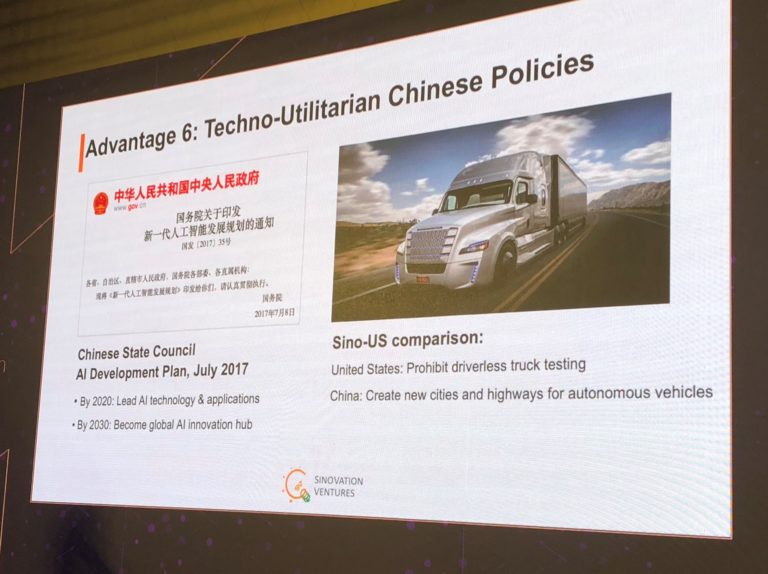
Finally, Some Pretty Cool Slides
I thought these were the most interesting slides from Dr. Lee’s presentation. It basically shows what jobs are going to be replaced by AI.


That’s it for today. Cheers, Jeff
—–
Related articles:
- Why I Really Like Amazon’s Strategy, Despite the Crap Consumer Experience (US-Asia Tech Strategy – Daily Article)
- 3 Big Questions for GoTo (Gojek + Tokopedia) Going Forward (2 of 2)(Winning Tech Strategy – Daily Article)
- Why Netflix and Amazon Prime Don’t Have Long-Term Power. (2 of 2) (US-Asia Tech Strategy – Daily Article)
From the Concept Library, concepts for this article are:
- State Capitalism
- Artificial Intelligence
From the Company Library, companies for this article are:
- Meituan
——–
